List of flags of Ireland
This is a list of flags which have been, or are still today, used on Ireland.
Island of Ireland
The following flags have been used to represent the island of Ireland as a whole, either officially or unofficially.
| Flag | Date | Use | Description |
|---|---|---|---|
 | 1386–1541 | The heraldic banner of the Lordship of Ireland was based on its coat of arms. The earliest depiction of the 'triple crown' motif is found on the arms granted by Richard II to Robert de Vere as Lord of Ireland in 1386. "They were borne, apparently as the arms of Ireland, in the funeral procession of Henry IV in 1413. They appear as a device on the Irish coinage of Edward IV (1461–83), Richard III (1483–85), Henry VII (1485–1509), and the pretender, Lambert Simnel (1487). Edward IV specified them as the Irish arms in an indenture of 1483".[1] The 'triple crown' motif has been traditionally associated with St. Edmund, the Saxon king of East Anglia (855–869) who is today one of the patron saints of England. The flag of East Anglia was a St. George's Cross with a blue coat of arms featuring three gold crowns – visually similar to the arms of the province of Munster. In his work 'Vicissitudes of Families', Bernard Burke, the Ulster King of Arms, proposed that St. Edmund's Banner was borne during the Norman Invasion of Ireland. A section of Christ Church Cathedral in Dublin is dedicated to St. Edmund, although his iconography is not displayed. | The banner of the Lordship of Ireland was based on the arms and feature three golden crowns ordered vertically on a blue background with a white border. It is blazoned: "Azure, three crowns in pale Or, bordure Argent." |
.svg.png) | 1542–1801 | Standard of the Kingdom of Ireland. From 1801 has been incorporated in the lower-left quadrant of the Royal Standard of the United Kingdom | A silver stringed gold harp on a blue field. |
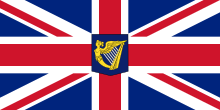 | 1821–1922 | Flag of the Lord Lieutenant of Ireland. This was granted in 1821, by the Lords Commissioners of the Admiralty under royal warrant, "to prevent the Inconvenience experienced for want of a flag distinguishing the presence of the Lord Lieutenant on board His Majesty's ships".[2] The flag became defunct when the office was abolished by the Irish Free State (Consequential Provisions) Act 1922. | The flag of the United Kingdom defaced with the coat of arms of Ireland. |
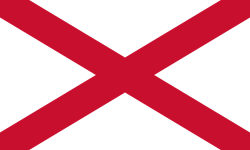 | 1783– | The St. Patrick's Saltire, also known as the Cross of St Patrick, after Saint Patrick, the main patron saint of Ireland. "The Saltire became an established Irish symbol in 1783 with the founding of the Order of Saint Patrick by King George III to mark the legislative independence of the Kingdom of Ireland which lasted from 1783 to 1801. The Saltire is believed to derive from the arms of the FitzGeralds who were the Earls of Kildare and later Dukes of Leinster. Incidentally, Kildare County Council uses the Saltire on its coat of arms, as do Cork City and Trinity College Dublin, that both feature two flags – St. George's Cross and St. Patrick's Saltire. The flags of Queen's University Belfast and the Royal College of Surgeons in Ireland use the symbol and it can also be found on the badge of the Police Service of Northern Ireland (PSNI)".[3] The flag has been used for almost 30 years by local authorities in Downpatrick for St. Patrick's Day. In addition, Church of Ireland flies this flag on special religious days throughout the island. The Saltire represents 'Ireland' in the flag of the United Kingdom. | The Saint Patrick's Saltire features a red saltire on a white field. In heraldry these arms are blazoned: "Argent, a saltire gules". |
.svg.png)  | ??-present | The green harp flag of the 17th century Confederacy of Ireland and an unofficial flag of Ireland during the 18th and 19th century. Variants have been used as the basis for numerous flags of Ireland. | A silver stringed gold harp on a green field. |
 | ??–present | The Four Provinces Flag of Ireland. This flag, and variants of it, have been used by various all-Ireland sports teams and cultural organisations. | The arms of the four provinces of Ireland are shown in quadrants. The order in which the arms appear varies. |
Northern Ireland
| Flag | Date | Use | Description |
|---|---|---|---|
.svg.png) | 1922–1973 | Personal flag of the Governor of Northern Ireland. | A Union Jack defaced with the Coat of arms of Northern Ireland. |
 | 1953–1972 | The Ulster Banner, also known as the Ulster flag or the Red Hand of Ulster flag, was the flag of the Government of Northern Ireland between 1953 and 1972. It was adopted in 1953 in honour of the Coronation of Queen Elizabeth II and was based on the arms that were granted to the Government of Northern Ireland in 1924 by the Ulster King of Arms based in Dublin Castle. The flag lost its official status in 1972 when the Parliament of Northern Ireland was abolished by the British government and since then there has been no 'official flag' for Northern Ireland. However, internationally, the flag is still used officially for sporting fixtures and events, such as the Commonwealth Games and by FIFA to represent the Northern Ireland national football team. Internally, the flag continues to be used by a number of local authorities and remains a divisive issue as it is mainly a symbol of Ulster loyalism.[3] | The flag is a heraldic banner and features the Red Hand of Ulster, a six-pointed star for the six counties of Northern Ireland and the British Crown on a St. George's Cross. |
.svg.png) | 1929–1973 | Ensign of the former Northern Ireland government. | The blue ensign defaced with the letters GNI. Used on vessels of the Northern Ireland government. |
Republic of Ireland
| Flag | Date | Use | Description |
|---|---|---|---|
 | 1922–present | Flag of Ireland | A tricolour, with three equal vertical bands of green (hoist side), white and orange; (the green symbolises Nationalism, the white Peace and the orange Unionism, therefore the flag represents peace between Nationalists and Unionists). This is the flag and naval ensign of Ireland. |
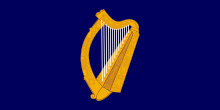 | 1945–present | The Standard of the President of Ireland was adopted in 1945, after the establishment of the Office of the President of Ireland (Uachtarán na hÉireann) in 1937. "This flag was approved by the Government on 13 February 1945. A number of technical decisions were made at the same time, including the decision that... the strings of the harp be yellow (in settlement of the question raised by Edward MacLysaght, who had insisted that the strings should be white)".[4] The Presidential Standard was introduced prior to the inauguration of Ireland's second President Seán T. O'Kelly and therefore, it was raised at Áras an Uachtaráin in the presence of President Douglas Hyde on 24 May 1945, a month before the inauguration of his successor on 25 June 1945.[3] The standard is flown over Áras an Uachtaráin and on vehicles used by the president. The flag is never flown at half mast and never takes precedence over the flag of Ireland. | The flag features a blue field and a gold harp with 14 diagonal golden strings. |
Defence Forces flags
Naval Service
| Flag | Date | Use | Description |
|---|---|---|---|
 | 1947–present | The Irish Naval Jack was adopted in 1947 after the establishment of the Naval Service (Ireland) (an tSeirbhís Chabhlaigh) in 1946.[1] It is flown at the bow and used to represent Ireland along with the Naval Ensign. The Naval Jack is flown "by Irish Naval Ships at the Jack staff when at anchor, moored, alongside or when under way and dressed with Masthead Ensigns. It is hoisted and half masted at the same time and in like manner as the Naval Ensign."[5] | The naval jack of the Naval Service of Ireland features a green field with a gold harp with 14 diagonal golden strings. |
 | 1996–present | Naval Service Colour Flag | Double-sided square banner. The primary colour is navy blue on both sides. The obverse side carries the Defence Forces badge at the centre superimposed over a pair of crossed silver foul anchors. The colour is bordered by a two-inch wide gold fringe Naval Service. |
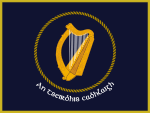 | 1996–present | Naval Service Colour Flag | Double-sided square banner. The primary colour is navy blue on both sides. A navy blue flag containing the state harp at its centre surrounded by a naval knotted rope decoration.Naval Service. |
Air Corps
| Flag | Date | Use | Description |
|---|---|---|---|
 | Irish Air Corps Flag | Composed of Red and yellow diagonal strips on a blue field with the emblem of Irish Air Corps at its centre, the emblem of Irish Defence forces on upper left and the Air Corps roundel on bottom right. This is the flag of the Irish Air Corps. | |
Army
| Flag | Date | Use | Description |
|---|---|---|---|
.svg.png) | 1966–present | The Military Colours of the 1st Brigade of the Irish Defence Forces were part of a set of six unit Colours that were designed in 1964. It was originally known as the Southern Command until the reorganisation of the army in 2012. There are now only two Brigades responsible for military operations in Ireland. | The Military Colours of the 1st Brigade are a field "divided per bend, or diagonally, yellow above and blue below, with a centrepiece of a stylised ship with a red hull and white sails encircled by a parti-coloured antique crown of yellow and blue. This device is a combination of details of the arms of the province of Munster and the city of Cork."[1] 'Óglaigh na hÉireann' is written across the top, which is the official Irish title for the Defence Forces (Ireland). 'An Cead Briogaid' is written at across the bottom and means '1st Brigade' in Irish. The badge of the Irish Defence Forces is placed in the right-hand corner (fly). |
.svg.png) | 1966–present | The Military Colours of the 2nd Brigade of the Irish Defence Forces were part of a set of six unit Colours that were designed in 1964 and were the first to be completed. They "were carried for the first time in the army parades and marches which formed part of the Dublin celebrations of the fiftieth anniversary of the 1916 rising at Easter 1966".[1] | The Military Colours of the 2nd Brigade are "divided per pale, or vertically, in two stripes, blue and green. The centrepiece shows a rising sun in yellow, on which are superimposed a flaming tower and a yellow harp device. The sun device is from the Irish Volunteer colours of 1914, the tower is from the arms of the city of Dublin and the harp is from the arms of the province of Leinster".[1] Óglaigh na hÉireann is written across the top, which is the official Irish title for the Irish Defence Forces. 'An Dara Briogaid' is written at across the bottom and means '2nd Brigade' in Irish. The badge of the Irish Defence Forces is placed in the right-hand corner (fly). |
.svg.png) | Air Defence Regiment Flag | Composed of an orange flag with a purple emblem of Air Defence Regiment at its centre. | |
.svg.png) | Defence Forces Infantry Corps Flag | Purple banner with two crossed rifles at its centre with the word coiste(Infantry) underneath, this is the flag of the Infantry Corps. | |
.svg.png) | Defence Forces Ordnance Corps Flag | A dark red colour flag containing the insignia of the Ordnance Corps at its centre. | |
.svg.png) | Defence Forces Cavalry Corps Flag | A black background flag containing the emblem of the Cavalry Corps at its centre. | |
.svg.png) | Defence Forces Engineer Corps Flag | A Yellow coloured background flag containing the emblem of the Engineer Corps at its centre. | |
.svg.png) | Defence Forces CIS Corps Flag | Blue background flag containing the emblem of the CIS Corps at its centre. | |
.svg.png) | Defence Forces Artillery Corps Flag | Orange flag with white border containing the emblem of the Artillery Corps at its centre. | |
.svg.png) | Defence Forces Medical Corps Flag | Teal coloured flag with white border containing the emblem of the Medical Corps at its centre. | |
Defence Force Training Centre (DFTC)
| Flag | Date | Use | Description |
|---|---|---|---|
.svg.png) | The Colours of the Defence Forces Training Centre represent the place "for all Defence Forces training, education and logistical units".[6] | The Colours of Defence Forces Training Centre feature a navy field, the shield of the Defence Forces Training Centre in the middle, its name in Irish at the bottom: ‘Airmheán Traenála Óglaigh na hÉireann’ and the badge of the Irish Defence Forces in the right-hand corner (fly). The shield depicts an oak leaf and two acorns. The Training Centre is located at the Curragh Camp in County Kildare. The name Kildare is the anglicised form of the Irish 'Cill Dara', which means 'church of the oak'. |
Coast Guard
| Flag | Date | Use | Description |
|---|---|---|---|
 | Coast Guard Flag | White background flag containing the emblem of the coast guard at its center, this is the flag of the Irish Coast Guard. | |
Provincial flags
| Flag | Date | Use | Description |
|---|---|---|---|
 | Flag of Ulster |
The arms of the nine-county province of Ulster form a composite achievement, combining the heraldic symbols of two of that province's best known families, namely the cross of de Burgo and the dexter hand of O Neill (Ua Néill, later Ó Néill) Kings of Ailech and Tír Eoghan. | |
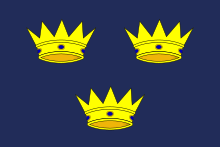 | Flag of Munster |
The province of Munster has been heraldically symbolised by three golden antique crowns on an azure blue shield. A crown of the type now known as antique Irish forms an integral element of a thirteenth-century crozier head found near Cormac's Chapel on the Rock of Cashel. In the case of the 'king-bishops' of Cashel, the placing of the antique crown on their crozier was a symbolic assertion of their right to the political sovereignty of Munster. | |
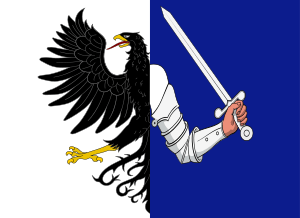 | Flag of Connacht |
The arms of Connacht use a dimidiated (divided in half from top to bottom) eagle and armed hand. Ruaidhri O'Conchobhair, King of Connacht, is surmised to have been conceded the arms of Schottenkloster or the Irish monastery founded in Regensburg, which approximate to the Connacht Flag of 1651 | |
 | Flag of Leinster |
A silver stringed golden harp on a green background. Possibly the oldest and certainly the most celebrated instance of the use of the harp device on a green field was the flag of Owen Roe O'Neill. It is recorded that his ship, the St Francis, as she lay at anchor at Dunkirk, flew from her mast top 'the Irish harp in a green field, in a flag'. | |
 | No history of flag use | The ancient Kingdom of Meath (Mide) was represented by the emblem of a king seated on a throne. There is no history of a flag ever being used, however an emblem was used which derived from iconography rather than classic heraldry. "The old province of Meath, which is nearly coextensive with the present day Diocese of Meath, is heraldically personified by a representation of a royal personage seated on a throne... It is, of course, fitting that Meath, wherein stood Tara, the symbolic site of the Kingship of Ireland, should be shown heraldically by a representation of a royal personage, or majesty, seated on a throne. The arms of Meath were apparently used at one time as the arms of Ireland, i.e. a majesty on a sable (black) background, the provincial arms being displayed on an azure (blue) field".[7] | The flag of Mide features a light blue field with a king sitting on a throne. The sceptre and outstretched right hand symbolise sovereignty and justice respectively. Today this emblem is used by the Meath GAA team but not the Meath County Council. |
County flags
| County | Irish name[8] | Province | GAA County Colours | GAA Colour Origins[9] |
|---|---|---|---|---|
| Antrim | Aontroim (Contae Aontroma) |
Ulster | The Antrim colours were adopted from the famous Shauns Club and have been worn since inter-county football began except for a short period. | |
| Armagh | Ard Mhacha (Contae Ard Mhacha) |
Ulster | Up to 1926 Armagh wore the same colours as Kilkenny. In 1926 they played Dublin in the All-Ireland Junior Semi-final and wore jerseys knit specially for them by nuns in Omeath in the colours which are used at present. | |
| Carlow | Ceatharlach (Contae Cheatharlach) |
Leinster | Up to 1910, Carlow used the colours of the county champions. In that year a set of green jerseys with red and yellow hoops were presented to the county teams. These colours with pattern changes have been used since. | |
| Cavan | An Cabhán (Contae an Chabháin) |
Ulster | Royal blue has been used by Cavan since 1910. The white trim was introduced for the 1947 All-Ireland Final against Kerry, which was played in the Polo Grounds in New York. | |
| Clare | An Clár (Contae an Chláir) |
Munster | Tulla was the first club to be established and the Clare jersey reflects this connection. Originally the jersey was saffron with a blue sash, but around 1920 the present hoop replaced the sash. | |
| Cork | Corcaigh (Contae Chorcaí) |
Munster | Cork played in a saffron and blue jersey, with a large C on the chest, up to 1919. These jerseys were confiscated by British authorities and the County Committee borrowed a set of red and white jerseys. These colours were then retained. | |
| Derry[10] | Doire (Contae Dhoire) |
Ulster | Red was the traditional Derry colour. In 1947 Derry played in the National League final in a set of white jerseys with a red band. These colours or the alternative of a red jersey with a white band have been worn since. | |
| Donegal | Dún na nGall (Contae Dhún na nGall) |
Ulster | Donegal have always worn green and gold and until 1966 wore green with a gold hoop. After a short spell wearing the gold jersey with green shorts, they returned to the hooped version in the late 70s and early 80s, before re-adopting the gold jersey for the All Ireland semi-final of 1992. | |
| Down | An Dún (Contae an Dúin) |
Ulster | A red jersey was worn by Down up to 1922. From 1923 a blue jersey with white trim was worn. In 1933 Down changed back to an all red jersey but with black collar and cuffs. Black shorts were first worn in 1962. | |
| Dublin | Áth Cliath (Contae Átha Cliath) |
Leinster | Dublin wore the colours of the Club Champions up to 1918 when the sky blue shade with the crest was adopted. The change to the present kit was made in 1974. | |
| Fermanagh | Fear Manach (Contae Fhear Manach) |
Ulster | Fermanagh originally used green and white hoops, the colours of the then County champions Teemore. Around 1934/35 a green jersey with yellow trim was used and this was later changed to white trim. Occasionally the county team wears a green jersey with red shorts. | |
| Galway | Gaillimh (Contae na Gaillimhe) |
Connacht | In Galway as in many other counties the colours of the county champions were used originally. The changeover to the present jersey took place in 1936 and the crest was added about 1956. Maroon shorts are occasionally worn. | |
| Kerry | Ciarraí (Contae Chiarraí) |
Munster | Up to the 1903 drawn All-Ireland Football Final, the Kerry colours were green and red. This was changed to green and gold for the replay, which saw Kerry win their first All-Ireland title. The colours have been retained since then. | |
| Kildare | Cill Dara (Contae Chill Dara) |
Leinster | The distinctive all-white strip of Kildare is taken from the colours of the Clane club, which won the county championship in 1903. | |
| Kilkenny | Cill Chainnigh (Contae Chill Chainnigh) |
Leinster | Kilkenny wore black and amber jerseys in their first All-Ireland final appearance in 1893, which had been bought from the Thomas Larkin Football Club. Kilkenny wore black and amber in the 1905 final when they beat Cork in a replay. Following a dispute between clubs on the county colours, a set of black and amber jerseys was presented to the county board by local council chairman John F. Drennan in 1911. These colours have been kept since.[11] | |
| Laois | Laois (Contae Laoise) |
Leinster | Laois wore a set of black and amber hoops in which they won their only All Ireland Senior Hurling Championship in 1915. The blue jersey with a white hoop was adopted in 1932 but Laois wore an all blue jersey with white trim when winning the Leinster football title in 2003. | |
| Leitrim | Liatroim (Contae Liatroma) |
Connacht | The Leitrim colours of green with a gold hoop date from about 1917, though white and green was sometimes worn in the 1920s. In 1927 when playing Kerry in the All Ireland Semi-final in Tuam they wore the Dublin jerseys. In the early 1990s Leitrim dropped their hoop and now play in green with a gold trim. | |
| Limerick | Luimneach (Contae Luimnigh) |
Munster | Limerick wore green with a white sash when winning the 1918 All Ireland Final but in the 1921 final wore green and white hoops. The present jersey was adopted in 1924. | |
| Longford | An Longfort (Contae an Longfoirt) |
Leinster | Green and white hooped jerseys were used by Longford up to 1918 when a royal blue jersey with a gold sash was adopted. Around 1930 the sash disappeared but the gold trim was retained. | |
| Louth | Lú (Contae Lú) |
Leinster | Louth have worn red and white colours since 1885. In 1957, when Louth won the All Ireland, a St Brigids Cross was presented to the team and the crest was included on the jersey in 1958. | |
| Mayo | Maigh Eo (Contae Mhaigh Eo) |
Connacht | Mayo's teams play in green and red, most often with a red hoop and trimming on a green jersey. The colours are taken from The Green above the Red, a poem by Young Ireland leader Thomas Davis about raising the green Irish flag above the red of England after a nationalist rebellion.[12] The colours were first popularised in Mayo by the Tower Hill club, and officially adopted by the county as a whole in the 1880s.[11] | |
| Meath | An Mhí (Contae na Mí) |
Leinster | A green jersey with a gold sash was used by the Meath team from 1908. The sash eventually disappeared, being replaced by the all green jersey with gold trim. | |
| Monaghan | Muineachán (Contae Mhuineacháin) |
Ulster | In Monaghan, up to 1913, the colours of the county champions were worn. The white jersey then had a blue band around 1920. Black and amber were used for a while in the mid-30s but in 1942 the original white with blue trim was reintroduced. | |
| Offaly | Uíbh Fhailí (Contae Uíbh Fhailí) |
Leinster | The national colours were very popular with clubs and counties in the early days of the GAA. Offaly earned the right to use them in Leinster as a result of a special competition. Several variations of the colours have been worn in recent years. | |
| Roscommon | Ros Comáin (Contae Ros Comáin) |
Connacht | The Roscommon jersey was either black and amber or black and white prior to 1938. Blue with a yellow band was also used. The present colour scheme was adopted for the 1943 final. | |
| Sligo | Sligeach (Contae Shligigh) |
Connacht | At one time the Sligo jersey was all black, before a white band was introduced around 1925. In 1970 the county teams adopted a white jersey with black trim and black shorts which they used for 30 years, but the team changed to the original all black in 2001. The team jerseys are commonly black with a white hoop and trimming. | |
| Tipperary | Tiobraid Árann (Contae Thiobraid Árann) |
Munster | Up to about 1925 the Tipperary team usually wore the colours of the county champions. In 1925 the present gold hoop on a blue jersey was introduced. These colours reflected the influence of Tubberadora and other great Tipperary champions. | |
| Tyrone | Tír Eoghain (Contae Thír Eoghain) |
Ulster | The present Tyrone jersey has been used since around 1927. The crest is the Red Hand of the O'Neill clan whose family seat was at Dungannon. | |
| Waterford | Port Láirge (Contae Phort Láirge) |
Munster | Waterford first took the royal blue of Munster with white cuffs for its county jersey. In 1938 the jersey was changed to white with royal blue trim. | |
| Westmeath | An Iarmhí (Contae na hIarmhí) |
Leinster | Up to 1912, Westmeath wore a green jersey with a white hoop. This was later changed to a maroon jersey with a saffron sash. The sash was dropped in 1936 and the present jersey has been used ever since. | |
| Wexford | Loch Garman (Contae Loch Garman) |
Leinster | In the 1891 Hurling Final Wexford (Crossbeg) wore green and amber. In 1899 Blackwater represented the county wearing black and amber. Purple and amber was introduced in 1913. The placing of the colours has alternated over the years. | |
| Wicklow | Cill Mhantáin (Contae Chill Mhantáin) |
Leinster | Bray Emmets were Wicklow county champions at the turn of the century and wearing a green jersey won the All- Ireland club championship of 1901–02. The Wicklow inter-county team wore green until the early 1930s. Blue with a gold hoop was then used until the changeover to the present style in 1970. |
City and town flags
| Flag | Date | Use | Description |
|---|---|---|---|
 | 1885–present | The flag of Dublin City was adopted in 1885 by the Dublin Corporation. In the canton it features 'three burning castles' which are part of the coat of arms of the city that were officially granted in 1607 by the Ulster King of Arms, Daniel Molyneux. The arms was a corruption of the earlier seal of Dublin that featured one castle with three watchtowers on the obverse and a ship on the reverse, whose earliest mention was in 1230. The seal of Dublin was based on the arms of Bristol as King Henry II granted the city to his men of Bristol with the 1171 Charter. This meant that Bristol merchants took control of colonisation of the Dublin city after the Norman invasion of Ireland.[13] The flag is flown over Dublin City Hall, the Mansion House and around the city, both indoors as well as outdoors. It acts as the de facto flag of the Dublin City Council. | The flag of Dublin City features a green field with a gold harp and three white two-towered burning castles on a navy canton. The gold harp represents both Ireland and Leinster, while the three burning castles are the lesser coat of arms of the city. Green and blue are the two national colours of Ireland. |
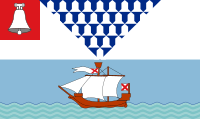 | 1890–present | Flag of Belfast is a heraldic banner that is based on the shield of the coat of arms of the city. The arms were granted in 1890, two years after Belfast was awarded city status by Queen Victoria. Although the banner was adopted in 1890, it has seldom been used. "The precise origins and meanings of the symbols contained on the Coat of Arms are unknown. But images such as the bell, the seahorse, the ship and the chained wolf were all used by 17th-century Belfast merchants on their signs and coinage. The seahorse, which is used twice, shows the maritime importance of Belfast, as does the ship at the base of the shield".[14] | The flag of Belfast is a horizontal bicolour of white and light blue. It features a silver bell in a red canton, a triangle of Vair(type of heraldic pattern) and a ship on waves with a Saint Patrick's Saltire as a naval ensign and masthead. |
 | 2012–present | Flag of Drogheda town was adopted by Drogheda Borough Council in 2012 and features a triband of red and black which are considered to be the 'town colours' and the coat of arms of Drogheda town. The exact origins of the arms are obscure due to the records being lost in a fire. Some believe that the 'castle and ship' element on the shield is derived from the arms of Bristol, in the same way as the 13th century Dublin seal. Others feel that the castle represents Saint Laurence Gate, while the ship stands for the river Boyne and Drogheda port. The 'star and crescent' emblem has the same origin as the coat of arms of Portsmouth and is taken from the arms of Richard I of England (Lionheart) who adopted it during the Third Crusade. The three lions 'passant guardant' are also derived from Richard I who began to use the emblem in 1198 to represent his position as King of the English, Duke of the Normans and Duke of the Aquitaines. These emblems honour the king, during whose reign Drogheda was granted its charter in 1194 by Hugh de Lacy. Since the 'Local Government Reform Act 2014' that came into effect from 1 June 2014, Drogheda Borough Council no longer exists and is now part of Louth County Council. | The flag is a vertical triband of red-black-red and features the coat of arms of Drogheda in the centre. The town's motto reads: Deus praesidium, mercatura decustranslates, which means "God our strength, merchandise our glory". |
 | 2013–present | The unofficial flag of Dún Laoghaire–Rathdown County Council was adopted in August 2014. It was originally designed and used for Bratacha 2013 – Ireland's first ever 'Festival of Flags and Emblems'.[15] The design concept was based on a combination of the Dún Laoghaire Rathdown County Council emblem, the coat of arms and on a loose translation of the County motto: Ó Chuan go Sliabh, meaning ‘from harbour to mountain’. Today the flag flies every weekend at the County Hall in the town of Dún Laoghaire. | The unofficial flag of Dún Laoghaire Rathdown County Council has a yellow field and features a green shamrock with two strokes – green and blue. The green stroke represents the mountains, while the blue one stands for the sea. This reflects the fact that the County is bordered by the Irish Sea and the Wicklow Mountains. |
Sporting flags
| Flag | Date | Use | Description |
|---|---|---|---|
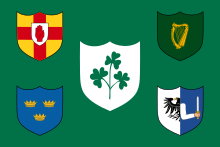 | 1925–present | Flag of the Irish Rugby Football Union | The arms of the four provinces of Ireland emblazoned on a green flag with a shamrock shield at its centre |
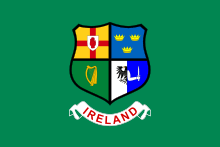 | 2000–present | The flag of the Irish Hockey Association was adopted in 2000 when the Irish Hockey Union and Irish Ladies Hockey Union merged. | The flag features a green field with a coat of arms quartered with the arms of the four provinces of Ireland. The association represents the whole island of Ireland and this is reflected in the flag. |
 | Flag of the Ireland cricket team | Three shamrocks on a blue background. | |
| 1911–present | Flag of the Irish Amateur Boxing Association | The four provinces shield of Ireland in the centre of a white flag | |
Ensigns
| Flag | Date | Use | Description |
|---|---|---|---|
 | Ensign of the Clontarf Yacht Club | A blue field with the Irish flag in the canton and a red bull in the fly. | |
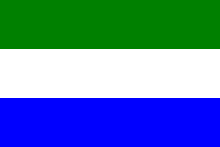 | Erne flag | Flown by boats on the Shannon-Erne Waterway, which bisects the Irish border. A horizontal tricolour of green, white and blue. | |
 | Ensign of the Howth Sailing Club | A blue field with the Irish flag in the canton and a red anchor in the fly. | |
 | Ensign of the Inland Waterways Association of Ireland | A light blue field with the Irish flag in the canton and a wavy set of stripes in the fly. | |
 | Ensign of the Lough Derg Sailing Club | A blue field with the Irish flag in the canton and a trio of gold shamrocks in the fly. | |
 | Ensign of the Malahide Yacht Club | A white field with the Irish flag in the canton and a black shield with a good cross in the fly. | |
| 1945–present | Ensign of the National Yacht Club | An azure blue field with a silver harp and the Flag of Ireland in the canton. | |
_pre-1945.svg.png) | pre–1945 | Ensign of the National Yacht Club | An azure blue field with a gold harp in the centre. |
 | Ensign of the Royal Cork Yacht Club | A dark blue field with the Irish Flag in the canton and a harp and crown in the fly. | |
.svg.png) | 1801–1948 | Ensign of the Royal Cork Yacht Club | The red ensign with the Union Jack defaced in the centre with a green square featuring a gold crown and harp. |
 | Ensign of the Royal Irish Yacht Club | A white field with the Irish Flag in the canton and a harp and crown in the fly. | |
.svg.png) | 1831–1846 | Ensign of the Royal Irish Yacht Club | A white field divided by a red St. George's Cross, with a Union Jack in the canton, and a gold harp on a blue background in the lower fly. |
 | Ensign of the Royal St. George Yacht Club | A dark blue field with the Irish Flag in the canton and a Tudor Crown in the fly. | |
 | Ensign of the Royal Ulster Yacht Club. | The blue ensign defaced with the Red Hand of Ulster and St Edward's Crown. | |
 | Ensign of the Royal Western Yacht Club of Ireland | A dark blue field with the Irish flag in the canton and a crown and garland in the fly. | |
 | Ensign of the Skerries Sailing Club | A blue field with the Irish flag in the canton and a yellow silhouette of a goat's head in the fly. | |
.svg.png) | circa 1701 – post 1800 | A Green Ensign flown by some Irish merchant vessels. | A gold harp on a green background with the English Flag in the canton. |
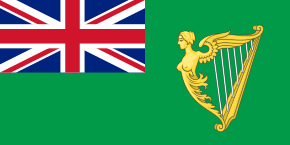 | post 1800 – c.1922 | A later version of the Green Ensign. | A gold harp on a green field with the Union Flag in the canton. |
.svg.png) | 1893–1907 | Ensign of the Congested Districts Board for Ireland | A Blue Ensign with the letters "C.D.B." in red in the fly, with a crown above them and a harp below them. |
.svg.png) | 1907–1916 | Ensign of the Congested Districts Board for Ireland | A Blue Ensign featuring a harp with a crown above it the fly, with the letter "C" to the left of the crown, the letter "D" above it and the letter "B" to the right of it, all surrounded by a red lozenge. |
.svg.png) | circa 1900–1922 | Ensign of the Department of Agriculture | A Blue Ensign with a white disc in the fly containing a smaller blue disc surrounded by a wreath of shamrocks in which there is a harp. |
| 1942–1986 | House flag of Irish Shipping Ltd, the state owned merchant shipping company | St. Patrick's Saltire, surrounded by the shields of the four provinces |
Historical military flags
| Flag | Date | Use | Description |
|---|---|---|---|
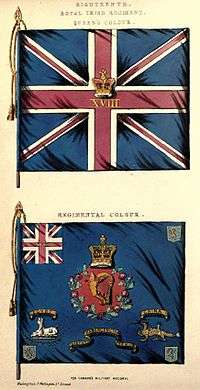 | 1684–1922 | Flag of the Royal Irish Regiment (1684–1922) of the British Army. Also known as the 18th (Royal Irish) Regiment of Foot and the 18th (The Royal Irish) Regiment of Foot | |
 | 1688–1791 | Flag carried in different variations by the Irish Brigade of the French Army | red and green cross, with motto "In Hoc Signo Vinces" |
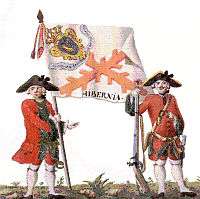 | 1710–1815 | Flag of the Regiment of Hibernia aka the "O'Neill's Regiment" of the Spanish Army | |
 | 1770s–1780s | The flag of the Dublin Volunteers; a militia unit raised in Ireland during the late 1770s as part of the wider Irish Volunteer movement. | Red background featuring the St Patricks Cross (also the arms of the Duke of Leinster, who led the regiment). |
 | 1770s–1780s | The flag of the Ormond Union Cavalry; a militia unit raised in Ireland during the late 1770s as part of the wider Irish Volunteer movement. | Features the motto "Pro aris et focis" ("For God and country") |
 | 1770s–1780s | The flag of the Parsonstown Volunteers; a militia unit raised in Ireland during the late 1770s as part of the wider Irish Volunteer movement. | Features the motto "Vis unita fortior" ("United Strength is Stronger") |
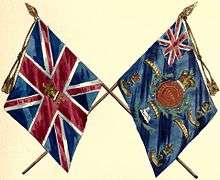 | 1793–1881 | Flag of the 86th (Royal County Down) Regiment of Foot of the British Army | |
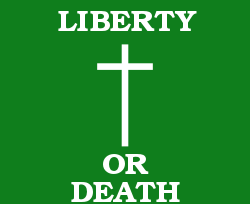 | 1798 | Flag carried by the United Irishmen at the Battle of Arklow | Green background with white Christian cross and the slogan "Liberty or Death". |
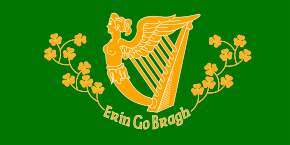 | 1846–1848 | The green silk flag of the Saint Patrick's Battalion of the Mexican Army may have incorporated the old Irish Harp flag (illustrated), which may date back to the Irish Confederacy. However, no original depictions are extant, and period descriptions of it differ. | Green background with Irish Harp, shamrocks and Motto Erin Go Bragh in Gold |
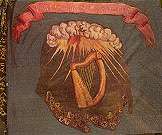 | 1861–1864 | Colour of the 28th Massachusetts Infantry regiment of the Irish Brigade (US) of the Union Army | Green background with Irish Harp and motto Faugh a Ballagh (Clear the Way!) |
| 1861–1864 | 2d Irish Color of the 69th Infantry Regiment (New York) of the Irish Brigade (US) of the Union Army | Green background with Irish Harp |
University flags
| Flag | Date | Use | Description |
|---|---|---|---|
 | 1910–present | Flag of Queen's University Belfast is a heraldic banner that is based on its coat of arms which were granted on 24 March 1910, two years after the establishment of the university. The arms are similar to those used by the Queen's University of Ireland which existed from 1850 to 1879.[16] | The banner is a Saint Patrick's Saltire that features a book, a sea horse, the Red Hand of Ulster, a harp and a British crown. The book stands for the university, the sea horse represents Belfast, the Red Hand is for Ulster, the harp symbolises Ireland and the crown is for the British monarchy. The university's arms are blazoned as: "Per saltire azure and argent, on a saltire gules, between in chief an open book and in base a harp both proper, in dexter a hand couped of the third, and in sinister a sea-horse vert gorged with a mural crown of the fourth, an Imperial crown of the last". |
| The flag of the University of Dublin incorporates its coat of arms which were granted in the nineteenth century on a blue field. The flag is flown over Trinity College Dublin on commencements days. | |||
| Flag of the Royal College of Surgeons in Ireland | |||
Organisations
| Flag | Date | Use | Description |
|---|---|---|---|
 | 2013–present | Flag of Vexillology Ireland was adopted by the Genealogical Society of Ireland on 4 July 2013. It was first used to represent the society at the 25th International Congress of Vexillology (ICV) in Rotterdam which was held from 4–10 August 2013. | The flag features a St. Patrick's blue (Azure) field, a gold (Or) harp with 12 vertical golden strings and a white (Argent) knotted rope (sheet bend) which stands for the International Federation of Vexillological Associations and is also an international symbol for vexillology. The official Pantone colours are: White, Blue 7455, Yellow 7409. |
Political flags
| Flag | Date | Use | Description |
|---|---|---|---|
 | 1800s | Earlier version of the Sunburst flag. This device was adopted by the Fenians in 1843. | A golden rising sun on a green field. It was supposedly based on earlier Nationalist flags. It can be seen in the National Museum of Ireland, Dublin. |
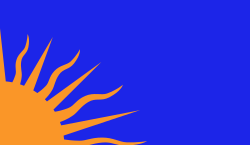 | 1893–present | The Sunburst flag, based on the flag of the mythological warriors the Fianna. | Blue background with a golden sunburst showing partially in the bottom left corner. Used by nationalists and republicans. |
.svg.png) | 1914–present | The Starry Plough Banner made its first appearance at an Irish Citizen Army meeting on 5 April 1914. It was flown on O'Connell Street above the Imperial Hotel (Clery's) during the 1916 Easter Rising. It was believed to have been destroyed but was later discovered. It had been seized by a British officer who returned the flag to the Irish government in 1955. The flag was in a decrepit condition until it was restored with funding from the Irish Labour Party in 2013 and displayed at the National Museum of Ireland – Decorative Arts and History. It is believed that the banner was designed by the art teacher William H. Megahy. His original drawing featured a blue rather than a green field and was presented to the National Museum in 1954 by the playwright Seán O'Casey who was the secretary of the Irish Citizen Army before the Easter Rising.[1] A statue of James Connolly with a bronze depiction of the Starry Plough that featured on the banner is located underneath the railway bridge on Beresford Place in Dublin. It was at this location that Connolly frequently addressed political and trade union rallies. The banner is still used today in the form of a flag by certain Irish socialist groups. | The banner features a green field bordered by a gilt fringe with a gold stylised representation of an agricultural plough that is superimposed by 7 silver stars forming the constellation Ursa Major, commonly known as 'the Plough'. |
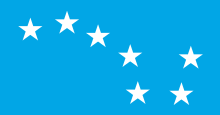 | 1934–present | "In 1934, the largest trade union, the Irish Transport and General Workers Union (ITGWU), introduced a simplified version of the Starry Plough with a sky-blue field, resembling the Alaskan flag adopted 7 years earlier. It was adopted as the emblem of the Irish Labour movement, including the Irish Labour Party, although they eventually dropped it".[17] Today the flag is used by various Irish socialist, nationalist and republican groups. | The Starry Plough flag (An Camchéachta) features a light blue field with 7 five-pointed white stars forming the constellation Ursa Major, commonly known as 'the Plough'. |
 | 1916 | On 24 April 1916, a flag with the inscription 'Irish Republic' was hoisted alongside the Irish tricolour over the General Post Office, Dublin during the 1916 Easter Rising as a proclamation of the Irish Republic. A photograph was taken of it flying on the south-eastern corner of the GPO by a guest staying in the Metropole Hotel. "It remained on the roof throughout the week, survived the bombardment and the fire which destroyed the G.P.O and was eventually removed by the troops after the insurgents' surrender, either on Sunday, 30 April or on the following day. A photograph taken at the time shows a group of soldiers holding it upside down at the base of Parnell monument in O'Connell Street. Thereafter, it was placed in the Imperial War Museum, London. It was presented by the British government to the Irish government on the fiftieth anniversary of the rising in 1966".[1] | The flag features a green field with the inscription "Irish Republic" written in white and yellow (gold) letters in the form of Gaelic script. It measures 4 feet 3 inches by 5 feet 6 inches and is now on display at the National Museum of Ireland – Decorative Arts and History. |
.svg.png)  | 1858 | Flags used by the Fenian Brotherhood which was founded in Dublin on St Patrick's Day 1858. | Two flags used in the past by the Fenian Brotherhood. The first Flag is based on the American 'Stars and Stripes' It has four bars representing the provinces of Ireland and 32 stars representing the counties.
The second flag is a green banner defaced with 32 gold stars to represent the Irish counties. It was captured from the Fenians during the Battle of Tallaght, 1867. |
 | 1932–1933 | Historical flag of the Blueshirts paramilitary group, associated with Fine Gael. It bore the St. Patrick's Saltire defacing a dark blue background. | A red saltire on a blue field. |
 | Flag of the Orange Order, a Protestant fraternal organisation based mainly in Northern Ireland, though it has lodges throughout the Commonwealth and a small number in the Republic of Ireland. | An orange field with a purple five-pointed star in the lower fly and a St. George's Cross in the canton. | |
 | The Purple Standard, used by some Orange Order marching groups. | A purple field with an orange five-pointed star in the lower fly and a St. George's Cross in the canton. Effectively an inverted version of the primary Orange Order flag. | |
 | Flag of the Apprentice Boys of Derry, a Protestant fraternal organisation based in Derry City, Northern Ireland. | A crimson field. |
Religious flags
| Flag | Date | Use | Description |
|---|---|---|---|
 | 1932 | A flag designed for the 1932 Eucharistic Congress in Dublin, which was carried to various ceremonies during the event. | A gold symbol of the Eucharistic Congress on a light blue field. |
Former national flag proposals
| Flag | Date | Use | Description |
|---|---|---|---|
.svg.png) | Proposed on 2 June 1928 | Flag proposed for a United Ireland by a Southern royalist in The Irish Times. | A gold harp with a crown above it, surrounded by the arms of the four provinces, all on a dark blue field. |
.svg.png) | Proposed on 6 June 1937 | Flag proposed in a letter to Éamon de Valera by an unknown designer, who suggested that a red cross be added to the Irish tricolour to symbolise the Christian faith of the Irish people.[18] | The Irish tricolour with the white band divided by a red cross. |
.svg.png) | Proposed in 1939, and again in 1945 | Flag proposed by an unknown Irishman, which appeared in The Irish Times on 19 June 1945. | A gold harp surrounded by a circle of twelve green shamrocks on a dark blue field. |
.svg.png) | Proposed in 1951 | Flag endorsed by both Sligo and Dublin County Councils. This proposal involved adding a blue Celtic Cross to the centre of the Irish tricolour to symbolise the Christianity and Faith of the Irish people. It appeared in the Drogheda Independent on 13 January 1951.[19] | The Irish tricolour defaced with a blue Celtic Cross in the centre. |
.svg.png) | Proposed on 10 June 1957 | Flag proposed in a letter Éamon de Valera by a John Harrington, who suggested that Ireland should replace its "atheistic tricolour" with a cross, so that Ireland would be the only Catholic country in the world to feature a cross on its flag. | A white cross with an orange field containing a green shamrock in the first quarter, and green fields in the second, third and fourth quarters. |
See also
- Cross-border flag for Ireland
- GAA county colours
- List of Northern Irish flags
- Northern Ireland flags issue
References
- Hayes-McCoy, Gerard Anthony (1979). A History of Irish flags from Earliest Times. Academy Press, Dublin. ISBN 978-0-906187-01-2.
- "Notice of Royal Warrant appropriating to the Lord Lieutenant of Ireland the Union Flag charged in the centre with an escutcheon of the arms of Ireland". The London Gazette (17692): 702. 27 March 1821.
- Genealogical Society of Ireland (2015). Flagging Ireland: Irish Guide to Flag Design". Dublin. ISBN 978-1-898471-03-5.
- Ó Brógáin, Séamus. (1998). "The Irish Harp Emblem". Wolfhound Press, Dublin. ISBN 978-0-8632-7635-4.
- "NSR Crest – Naval Service Reserve – Organisation – Reserve – Defence Forces". Military.ie. Retrieved 9 January 2018.
- "DFTC – Organisation – Army – Defence Forces". Military.ie. Retrieved 9 January 2018.
- National Library of Ireland Heraldry in Ireland
- Gasaitéar na hÉireann / Gazetteer of Ireland. Dublin: Brainse Logainmneacha na Suirbhéireachta Ordanáis / Placenames Branch of the Ordnance Survey. 1989. ISBN 978-0-7076-0076-5.
- "County Colours". Gaa.ie. Archived from the original on 28 September 2015.
- Londonderry is often called Derry – see Derry-Londonderry name dispute
- "An Irishman's Diary". Irish Times. 16 May 2000. Retrieved 24 February 2018.
- "The Green above the Red (Author: Thomas Osborne Davis)". Corpus of Electronic Texts UCC. Retrieved 24 February 2018.
- Signage at the Dublin's City Hall's "The Story of the Capital" museum
- "Belfast Coat of Arms". Belfastcity.gov.uk. Archived from the original on 21 September 2015.
- "Bratacha 2013 Brochure" (PDF). Familyhistory.ie. Retrieved 9 January 2018.
- Bordeleau, A.G. (2014)."Flags of the Night Sky: When Astronomy Meets National Pride". Springer, New York. ISBN 978-1-4614-0928-1.
- "Letter to Éamon de Valera, 6 June 1937". Retrieved 12 June 2020.
- "Drogheda Independent, 13 January 1951". Retrieved 12 June 2020.
External links
| Wikimedia Commons has media related to Flags of Ireland. |
- Symbols in Northern Ireland – Flags Used in the Region by Dara Mulhern and Martin Melaugh; illustrated article from CAIN Project (Conflict Archive on the INternet)
- National Library of Ireland